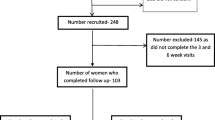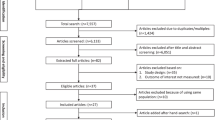Abstract
Postpartum anemia has been associated with postpartum morbidities, such as depression and poor cognition. However, it is unclear whether postpartum anemia is associated with reduced health-related quality of life. We performed a prospective study to examine the relations between postpartum Hb levels with postpartum health-related quality of life (HRQoL). We collected data from 60 women intending vaginal delivery and assessed HRQoL and maternal fatigue on admission and on the first postpartum day using the RAND 36-Item Short-Form Health Survey (SF-36) and the Multidimensional Fatigue Inventory (MFI), respectively. Maternal Hb levels were measured on admission and on the first postpartum day. We also assessed patients for postpartum depression using the Edinburgh Postpartum Depression Scale (EPDS). We performed unadjusted and multivariate linear regression (adjusting for maternal age, parity, mode of delivery, and race) to assess the associations between postdelivery Hb with each subscale of the SF-36 and MFI. The mean predelivery and postpartum Hb levels were 12.3 (1.2) and 10.8 (1.4) g/dl, respectively. In our unadjusted and adjusted regression analyses, we observed no statistically significant associations between postpartum Hb levels with any SF-36 or MFI subscale (P > 0.05). Based on the EPDS, only one patient was depressed; her postpartum Hb was 11.2 g/dl. Our findings suggest that postpartum Hb levels may not influence HRQoL or fatigue. However, our findings may only apply to women without predelivery anemia, severe blood loss or moderate-to-severe anemia after delivery. Future studies are needed to determine whether postpartum Hb influences HRQoL among women with moderate or severe postpartum anemia.
Similar content being viewed by others
References
Wilson IB, Cleary PD (1995) Linking clinical variables with health-related quality of life. A conceptual model of patient outcomes. Jama 273:59–65
Ware JE Jr, Brook RH, Davies AR, Lohr KN (1981) Choosing measures of health status for individuals in general populations. Am J Public Health 71:620–625
U.S. Department of Health and Human Services Healthy people (2020) Office of disease prevention health promotion., https://www.healthypeople.gov/
Brown S, Lumley J (2000) Physical health problems after childbirth and maternal depression at six to seven months postpartum. BJOG 107:1194–1201
Webb DA, Bloch JR, Coyne JC, Chung EK, Bennett IM, Culhane JF (2008) Postpartum physical symptoms in new mothers: their relationship to functional limitations and emotional well-being. Birth 35:179–187
Sakala C, Declercq ER, Corry MP (2002) Listening to mothers: the first national U.S. survey of women’s childbearing experiences. J Obstet Gynecol Neonatal Nurs 31:633–634
Schytt E, Lindmark G, Waldenstrom U (2005) Physical symptoms after childbirth: prevalence and associations with self-rated health. BJOG 112:210–217
Bergmann RL, Richter R, Bergmann KE, Dudenhausen JW (2010) Prevalence and risk factors for early postpartum anemia. Eur J Obstet Gynecol Reprod Biol 150:126–131
Lopez A, Cacoub P, Macdougall IC, Peyrin-Biroulet L (2016) Iron deficiency anaemia. Lancet 387:907–916
Beard JL, Hendricks MK, Perez EM, Murray-Kolb LE, Berg A, Vernon-Feagans L, Irlam J, Isaacs W, Sive A, Tomlinson M (2005) Maternal iron deficiency anemia affects postpartum emotions and cognition. J Nutr 135:267–272
Corwin EJ, Murray-Kolb LE, Beard JL (2003) Low hemoglobin level is a risk factor for postpartum depression. J Nutr 133:4139–4142
Jansen AJ, Duvekot JJ, Hop WC, Essink-Bot ML, Beckers EA, Karsdorp VH, Scherjon SA, Steegers EA, van Rhenen DJ (2007) New insights into fatigue and health-related quality of life after delivery. Acta Obstet Gynecol Scand 86:579–584
Ware JE Jr, Sherbourne CD (1992) The MOS 36-item short-form health survey (SF-36). I. Conceptual framework and item selection. Med Care 30:473–483
Smets EM, Garssen B, Bonke B, De Haes JC (1995) The Multidimensional Fatigue Inventory (MFI) psychometric qualities of an instrument to assess fatigue. J Psychosom Res 39:315–325
Cox JL, Holden JM, Sagovsky R (1987) Detection of postnatal depression. Development of the 10-item Edinburgh Postnatal Depression Scale. Br J Psychiatry 150:782–786
Jansen AJ, Essink-Bot ML, Duvekot JJ, van Rhenen DJ (2007) Psychometric evaluation of health-related quality of life measures in women after different types of delivery. J Psychosom Res 63:275–281
Murray L, Carothers AD (1990) The validation of the Edinburgh Post-natal Depression Scale on a community sample. Br J Psychiatry 157:288–290
Harris B, Huckle P, Thomas R, Johns S, Fung H (1989) The use of rating scales to identify post-natal depression. Br J Psychiatry 154:813–817
Milman N (2008) Prepartum anaemia: prevention and treatment. Ann Hematol 87:949–959
WHO/UNICEF/UNU (2001) Iron deficiency anaemia: assessment, prevention and control, a guide for programme managers. World Health Organization, Geneva
Centers for Disease Control and Prevention (1998) Recommendations to prevent and control iron deficiency in the United States. MMWR Recomm Rep 47:1–29
World Health Organization (2011) Haemoglobin concentrations for the diagnosis of anemia and assessment of severity. Vitamin and mineral nutrition information system. Department of Reproductive Health and Research, WHO, Geneva
Ware JE Jr, Kosinski M, Bayliss MS, McHorney CA, Rogers WH, Raczek A (1995) Comparison of methods for the scoring and statistical analysis of SF-36 health profile and summary measures: summary of results from the Medical Outcomes Study. Med Care 33:AS264–AS279
Milman N (2006) Iron and pregnancy—a delicate balance. Ann Hematol 85:559–565
Van Der Woude D, Pijnenborg JM, Verzijl JM, Van Wijk EM, De Vries J (2014) Health status and fatigue of postpartum anemic women: a prospective cohort study. Eur J Obstet Gynecol Reprod Biol 181:119–123
Prick BW, Jansen AJ, Steegers EA, Hop WC, Essink-Bot ML, Uyl-de Groot CA, Akerboom BM, van Alphen M, Bloemenkamp KW, Boers KE, Bremer HA, Kwee A, van Loon AJ, Metz GC, Papatsonis DN, van der Post JA, Porath MM, Rijnders RJ, Roumen FJ, Scheepers HC, Schippers DH, Schuitemaker NW, Stigter RH, Woiski MD, Mol BW, van Rhenen DJ, Duvekot JJ (2014) Transfusion policy after severe postpartum haemorrhage: a randomised non-inferiority trial. BJOG 121:1005–1014
Albacar G, Sans T, Martin-Santos R, Garcia-Esteve L, Guillamat R, Sanjuan J, Canellas F, Gratacos M, Cavalle P, Arija V, Gaviria A, Gutierrez-Zotes A, Vilella E (2011) An association between plasma ferritin concentrations measured 48 h after delivery and postpartum depression. J Affect Disord 131:136–142
Murray-Kolb LE, Beard JL (2009) Iron deficiency and child and maternal health. Am J Clin Nutr 89:946S–950S
Lipschitz DA, Cook JD, Finch CA (1974) A clinical evaluation of serum ferritin as an index of iron stores. N Engl J Med 290:1213–1216
Milman N (2011) Postpartum anemia I: definition, prevalence, causes, and consequences. Ann Hematol 90:1247–1253
Richter C, Huch A, Huch R (1995) Erythropoiesis in the postpartum period. J Perinat Med 23:51–59
Author information
Authors and Affiliations
Corresponding author
Ethics declarations
Funding
The study was supported by the Department of Anesthesiology, Perioperative, and Pain Medicine, Stanford University School of Medicine. A.J.B was supported by an award from the Eunice Kennedy Shriver National Institute of Child Health and Development (K23HD070972).
Conflicts of Interest
The authors declare that they have no conflicts of interest.
Rights and permissions
About this article
Cite this article
Miller, C.M., Ramachandran, B., Akbar, K. et al. The impact of postpartum hemoglobin levels on maternal quality of life after delivery: a prospective exploratory study. Ann Hematol 95, 2049–2055 (2016). https://doi.org/10.1007/s00277-016-2817-5
Received:
Accepted:
Published:
Issue Date:
DOI: https://doi.org/10.1007/s00277-016-2817-5




